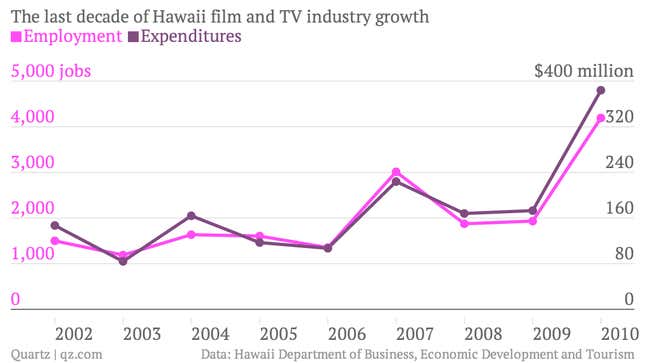Jack Shephard’s words at the end of season three of LOST (warning: spoilers) were not just ominous in the show’s context—they were also strangely prescient of Hawaii’s film and television industry. More and more movies and TV shows are going back to the state to film among its incredible beaches, mountains, and jungles. And these productions are huge job creators.
The Hawaiian film and TV industry saw an 84.9% increase in the number of jobs it created from 2001-2011, much greater than the 13.8% increase for Hawaii’s creative sector as a whole, which also includes marketing, music, radio broadcasting, etc.

Much of its success is due to the hit TV show LOST, which became a monstrous cultural phenomenon soon after its 2004 pilot and sent droves of tourists to the island of Oahu to visit the show’s many set locations. But Hawaii was home to major film and TV productions long before that—Raiders of the Lost Ark and Jurassic Park filmed there in 1980 and 1992, respectively.
The industry’s largest growth happened during the time that LOST was filming there (2004-2010). The show’s mysterious island became an important “character” over the course of the series, and was featured prominently. Part of what made Hawaii so attractive to LOST and other productions is its versatility. LOST managed to convincingly transform the island of Oahu into South Korea, Australia, England, Russia, and Iraq, among other locales.
In 2006, the state introduced an enticing 20-25% tax credit for production costs, provided that the film or TV show receiving the credit make financial contributions to the Hawaiian education system or workforce. (LOST was filmed entirely with a local film crew.) And in 2010, the Hawaii 5-0 remake came to town, replacing LOST as another popular, long-running TV show that filmed exclusively in the state. That same year, both Pirates of the Caribbean: On Stranger Tides and Tropic Thunder filmed in Hawaii.
Even during the recession, Hawaii’s film and TV industry grew. While Hawaii lost a net 0.7% of its jobs from 2007-2011, the film and TV industry grew 7.6% over the same period. Not only was it largely recession-proof, but it performed far better than the national average of the same industry. With all that growth, Hawaii’s creative sector generated $3.8 billion in economic activity in 2011, good for 6% of state GDP that year.

